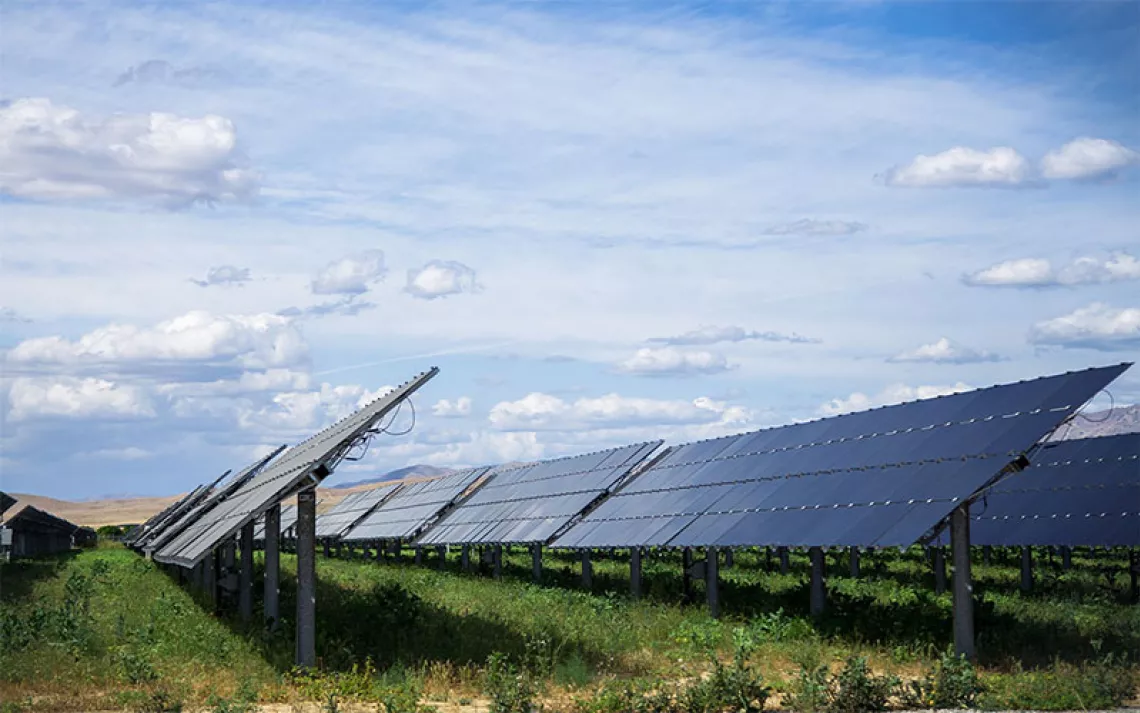The Electricity Is Melting
As glaciers see diminishing returns, is hydropower worth it?

A person walks along Glacier Chacaltaya in the Bolivian Andes. The glacier was once famous for having the world's highest ski run, but it no longer has enough snow. | Photo by Juan Karita/Associated Press
Glaciers sit high and heavy in the mountains, vast seas of ice suspended thousands of feet above cities and villages. The tremendous potential energy that makes avalanches so deadly has, in the past, made glaciers an enviable source of power for communities living downslope.
The water arrives just when they need it most. Glaciers store water over the winter and spring and gradually release it in the hot and dry months. In areas with long dry seasons, like the deserts west of the Andes, glaciers act as a buffer, keeping water flowing in periods of drought. La Paz, the capital city of Bolivia, normally gets about 16 percent of its water from glacier melt, but during droughts, that number can climb to 86 percent.
“You couldn’t design a better system,” says Mauri Pelto, a professor of environmental science at Nichols College in Massachusetts, who has monitored the glaciers in North Cascades National Park in Washington State for decades. “At the end of the summer, when there is no rain and there is no snow ... the glaciers kick in.”
But that ideal system is changing. The Chacaltaya Glacier, one of several supplying water to La Paz, disappeared in 2009, a victim of the fossil fuel industry. And earlier this year, a landslide and flash flood in February tore through two hydroelectric dams on the Dhauliganga River in the Indian state of Uttarakhand, killing at least 70 people, many of them dam workers who were trapped in construction tunnels. While not all scientists agreed as to how much of a role climate change played in the landslide, the IPCC has warned that melting ice will make landslides like this one more common.
To Manshi Asher, who has lived and worked for two decades in the western Himalayas as a researcher and is the cofounder of the environmental activist group Himdhara Collective, the disaster is a reminder of how little the Indian government’s hydropower projects have to offer mountain communities, relative to how much harm they can bring. Their projects typically use laborers from outside the community, and since the villages use very little electricity, the bulk of the power leaves the mountains and goes to the centralized grid to power cities like New Delhi.
Now, as global warming makes damming rivers an even worse idea, Asher wonders why hydropower should continue to take precedence over the many other uses for a river, like farming, fishing, and drinking. She sees even more reason to return control of the land and its resources to the people who live there. “Who do the mountains belong to? Who do the rivers belong to?” she asks. “This is public property.” She’s calling for a proper environmental review of all hydropower projects in the Himalayas and a halt to all projects over 25 megawatts.
What can replace a glacier?
Even in places where the local community does benefit from hydropower, the calculus of whether or not a dam is worth it is changing as fast as the warming planet. As glacier-powered hydro projects start to see diminishing returns, some municipalities are starting to grapple with the prospect of allocating limited water.
“Is electricity production the only goal that we have? Clearly it’s not,” says Daniel Farinotti, a glaciologist at ETH Zürich, a research institute funded by the Swiss government. Whether or not hydropower is a good investment is often “a question of values,” he says. But for regions that rely heavily on meltwater, the choice is especially urgent. “Once the glaciers have melted away, there's just nothing that will deliver your water.”
And it gets even more complicated. Melting glaciers mean less water in the long run, but in the short run the opposite is true, as increased warming chips away at ancient bodies of ice. Glaciologists speak in apocalyptic terms about “peak water,” a point in the not-so-distant future when meltwater from glaciers will be at its highest. As the world climbs the slope to peak water, some hydropower projects may temporarily become more valuable than ever, as more water melts away with each summer thaw.
“It's like drawing down your bank account: You have a surplus of money available, but it's then missing,” says Mathias Vuille, a professor of atmospheric and environmental sciences at the University of Albany who has watched glaciers in the Andes shrink before his eyes. Glaciers like Chacaltaya have long since passed peak water. For a time, global warming will boost the amount of water melting from glaciers. But after peak water, as the glaciers shrink, the water and energy they produce will drop to the point where the cost to local communities and ecosystems is too high to justify keeping a dam in place. The pressure to plan for this eventuality is already on in some places.
The Swiss Alps are home to some of the most picturesque glacial landscapes on Earth. Alpine glaciers are also a significant source of hydropower for the region and of revenue for rural communities, most of whom—unlike their counterparts in the Himalayas and Andes—own the water rights and lease the stream to power companies. “Hydropower is king” for these communities, says Bettina Schaefli, a hydrologist at the University of Bern.
But this resource is diminishing too. Combining maps of the region’s hydro plants with estimates of glacier loss, Schaefli and her colleagues showed in 2019 that nearly 4 percent of Switzerland’s hydropower had come from vanishing glaciers. “That will never come back,” she says. She predicts that peak water for the Alps will come sometime in the middle of this century, though she acknowledges that predictions are highly uncertain.
Switzerland plans to expand hydro as part of an effort to transition from nuclear energy and reach net-zero carbon emissions by 2050. But hydropower, which supplies about half of the country’s electricity, is already close to capacity, according to Schaefli. Even a small loss from melting glaciers diminishes hydropower’s role in the nation’s energy plan, which means the Swiss may need to install more gas-fired plants, solar panels, or wind farms.
The situation leads to some tough questions: “Is it more useful to build a dam at a remote place that no one sees ... and destroy many ecosystems? Or should you just build a few [wind] turbines on a mountaintop?” Schaefli asks. The latter option, she says, is so far a non-starter for those who want to preserve the pristine Alpine landscape as a tourist destination.
The Swiss government hopes to add about 2 terawatt-hours of clean energy by 2040. But its plan to expand hydropower has not yet incorporated the reality that the glacier is losing mass, according to Schaefli, who has worked on the Energy Strategy 2050 project. The energy transition policy is still in its early phase. In the coming years, the government will continue to weigh hydropower against other uses for diminishing water.
Trading hydropower for salmon
In 1927, the city of Anchorage, Alaska, constructed a small hydropower dam across the lower Eklutna River, a salmon stream fed in part by the Eklutna Glacier, which sits at an elevation of about 6,000 feet in the Chugach Mountains. About three decades later, the city abandoned it and built another hydroelectric operation higher upstream, directly below Eklutna Lake. They blasted a tunnel through the Chugach Mountains and diverted the lakewater four and a half miles north into the Knik River catchment. Today, the lake is the main source of drinking water for Anchorage, and the dam’s hydropower plant supplies about 6 percent of the area’s power.
That electricity has not been enough to justify the damage that lost water has caused, according to Brad Meiklejohn, a representative for the Conservation Fund in Alaska. “The utilities have been able to basically hijack all the water for going on 90 years now,” he says. Downstream from the lake, the Eklutna River is barely a trickle. Meiklejohn led a successful effort to remove the original 1927 “deadbeat dam” in 2018, at a cost of $7.5 million. The victory was largely symbolic—the water from Eklutna Lake is still diverted at the outlet—but the group is now in legal negotiations to determine how much water the utilities will release to keep the river high enough to provide a healthy habitat for salmon.
The movement to remove the dams and restore the river enjoys broad public support, including from the Alaska Federation of Natives. But in the short term, as the Eklutna Glacier melts, it may make the dam even more valuable as an energy source. Chugach Electric—one of three companies with a stake in the plant—expects to see an increase in water available for power generation as the glacier melts, according to company spokesperson Julie Hasquet.
But in a few decades, meltwater from the Eklutna glacier will pass peak water and start to permanently decline, and the glacier will likely disappear eventually, according to Louis Sass, principal investigator for the US Geological Survey’s Benchmark Glacier Project. The lake will remain, since it’s fed mostly by groundwater and precipitation, but the power plant will feel the pinch in the hot and dry months, when glacier melt would have made up the difference. The loss of hydropower from the vanishing ice may even increase energy prices, and Anchorage may decide a power plant with less power isn’t worth the environmental cost. Some have already made that decision.
“It's sort of an artifact of history,” says Meiklejohn. “Ninety years ago, nobody was really asking these kinds of questions. Alaska had salmon everywhere.” The Eklutna Denai’na, Anchorage’s original inhabitants, once fished for five kinds of salmon in the river. "Alaskans are very connected to salmon,” says Meiklejohn. “It's a part of our culture. And I think there's a recognition that dams and salmon don't play well together. Here's a case where we made a mistake; we should fix it. We need to have a diverse energy portfolio, but not at the cost of salmon."
Besides, he says, salmon are a renewable resource in their own right. Once the dams are gone, the fish can repopulate the river on their own. “All you have to do is stand out of the way, and they keep coming back.”
 The Magazine of The Sierra Club
The Magazine of The Sierra Club



